Opioid Substitution Therapy (OST) implicated deaths and prescribing: evidence review
This paper summarises current knowledge of trends around methadone and buprenorphine related deaths and changes to prescribing practice in Scotland.
2. Role of OST in drug-related deaths
Scotland continues to have a high level of drug-related deaths (DRDs). The annual figure for 2020 increased from the previous year by 4.6% to 1,339, the highest number ever recorded.[12] In addition there has been a similar increase in deaths where an OST drug (methadone or buprenorphine) was implicated. These are explored separately below.
2.1 Methadone implicated in drug-related deaths
Both the number and percentage of methadone-implicated deaths has increased over time. In 2020 methadone was implicated in 708 deaths, an increase of 25% on 2019 (567) and following a long term increase over the last twenty years (Figure 1).
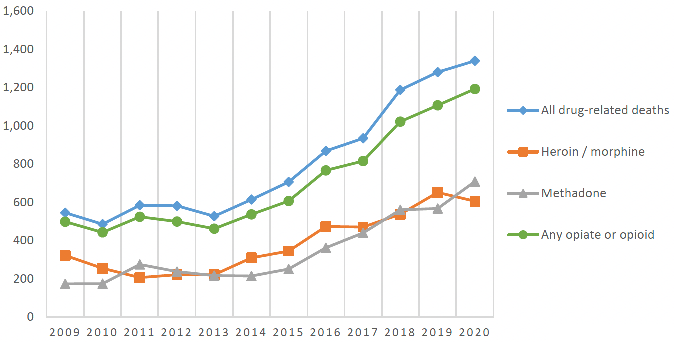
Source: NRS 2021
In 2020, methadone was implicated in 53% of all drug-related deaths. This is the highest percentage since records began, and continues a general upward trend with some fluctuations (Figure 2).
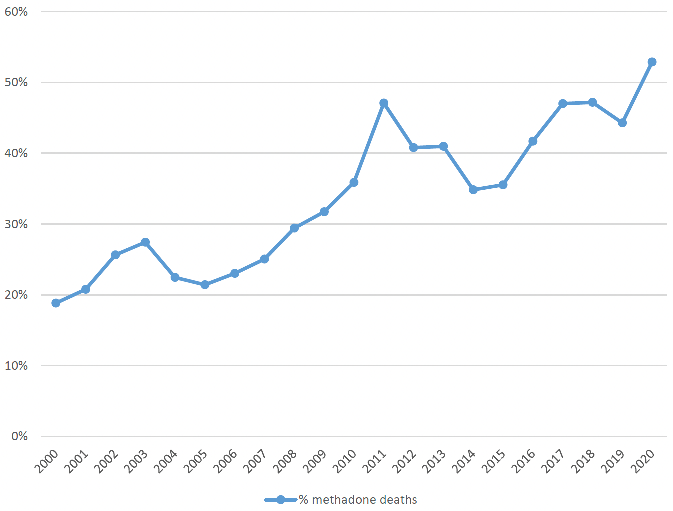
Source: NRS 2021
Figure 3 below shows methadone-implicated deaths in 2020 broken down by local authority area. Although Glasgow City had the highest absolute number of methadone-implicated deaths (177 of 291 DRDs), the highest percentage of methadone deaths relative to DRDs were in Perth & Kinross (73.5%, 25 of 34 DRDs) and Dumfries & Galloway (68.2%, 15 of 22 DRDs). A full table of deaths by local authority and NHS Health Board is available in Appendix 1.
Appendix 2 provides charts showing the change over time of the percentage of drug-related deaths where methadone was implicated, by health board area. Areas which have seen distinct upward trends in the percentage of DRDs where methadone was implicated are Fife, Greater Glasgow and Clyde, Lanarkshire and Tayside. Smaller health board areas with fewer DRDs present a more fluctuating picture.
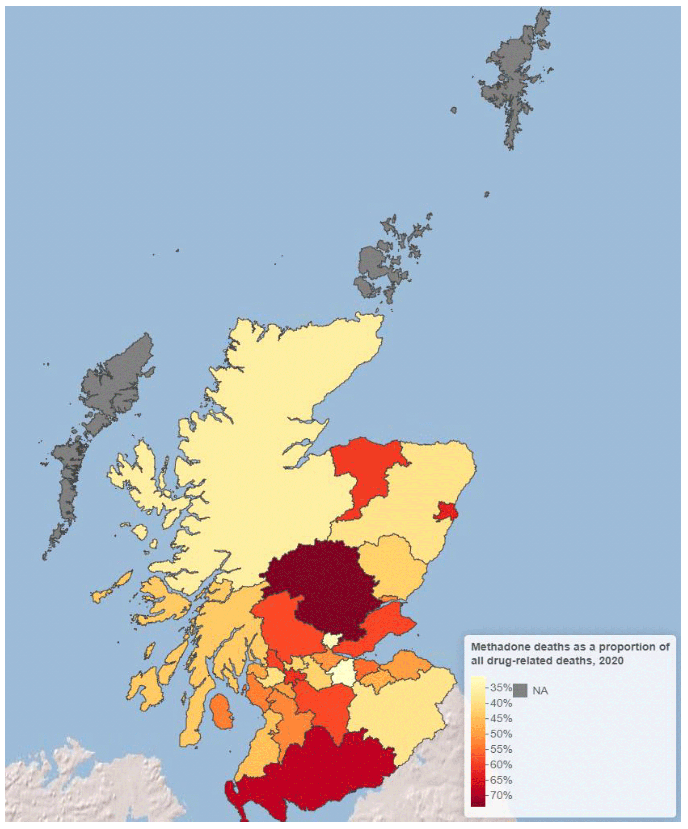
*Figures for LAs with fewer than 5 drug-related deaths have been suppressed
2.1.1 By age and sex
As with overall DRDs, the greatest number of methadone-implicated deaths in absolute terms in 2020 occurred in males, and those aged 35-54 (Table 1). The age distribution of methadone deaths is slightly older than the average for all DRDs, with 45.3% of all methadone-implicated deaths being among those aged over 45, compared with 43% of all DRDs. However, methadone-implicated deaths were proportionally more common among females than males, accounting for 59% and 51% of all DRDs, respectively. This is in line with evidence which suggests older age groups and women are more likely to be in treatment.[13]
| Methadone-implicated deaths | All DRDs | Percentage of all DRDs implicated by methadone | ||
|---|---|---|---|---|
| Gender | Male | 492 | 973 | 51 |
| Female | 216 | 366 | 59 | |
| Age | Under 25 | 19 | 80 | 24 |
| 25-34 | 118 | 260 | 45 | |
| 35-44 | 249 | 418 | 60 | |
| 45-54 | 249 | 419 | 59 | |
| 55 and over | 73 | 162 | 45 | |
| All | 708 | 1,339 | 53 | |
(Source: NRS 2021)
2.1.2 Drugs implicated in death
96.5% (685)of methadone deaths had more than one drug implicated, while only 23 methadone-implicated deaths had only one substance implicated. It is important to note that in cases where an OST is identified in toxicology results it is almost always thought to be implicated in death, rather than just present at death, and it is not possible to determine from the NRS data the relative contribution of different substances to the cause of death.
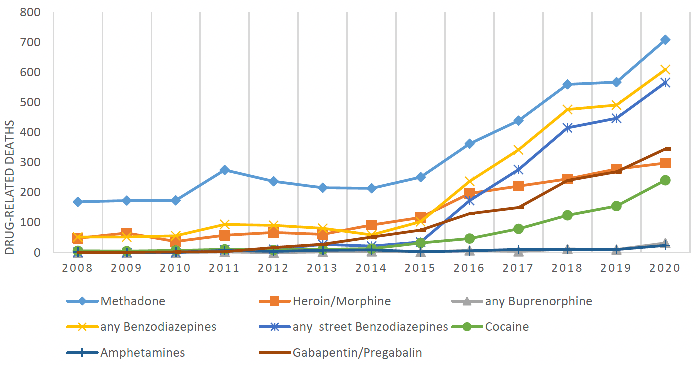
Source: NRS 2021
Figure 4 above shows that the most common combinations of substances in methadone-implicated deaths were:
- Benzodiazepines: implicated in 86% (609) of methadone-implicated DRDs. Illicit 'street' benzodiazepines accounted for the majority of cases (566 deaths, 80%).
- Gabapentinoids: implicated in 49% (345) of methadone-implicated DRDs.
- Heroin/Morphine: implicated in 42% (298) of methadone-implicated DRDs.
- Cocaine: implicated in 34% (241) of methadone-implicated DRDs.
2.2 Buprenorphine implicated in drug-related deaths
In 2020 there were 97 deaths where buprenorphine was implicated, accounting for 7% of all DRDs. This represents an 18% increase on 2019 (82 deaths). There has been a general upward trend over time, with a 169% increase since 2017 (36 deaths).[14] Due to the smaller number of buprenorphine-related deaths, data is available at a less granular level and it is not possible to robustly determine the geographic or demographic breakdown of buprenorphine-related deaths.
The number of buprenorphine deaths is smaller than the number of methadone-implicated deaths. However, far fewer individuals are prescribed buprenorphine and it is therefore less available than methadone. Patient estimates suggest the number of people prescribed methadone is approximately four times higher than the number prescribed buprenorphine.[15]
While numbers remain small, the percentage of all drug deaths where buprenorphine was implicated has increased dramatically, from 0.6% of all DRDs in 2010 to 7% in 2020. This is a greater increase than with methadone, and is partly a result of the increase in buprenorphine prescribing over the period.
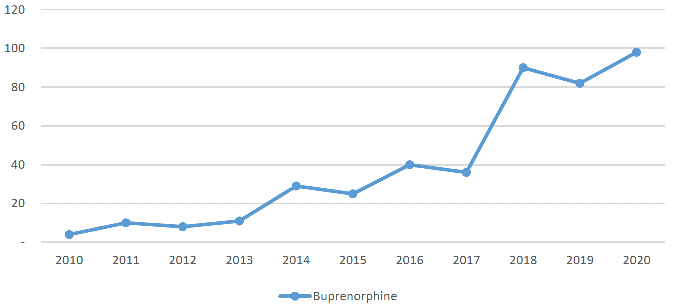
Source: NRS 2021
2.3 OST implicated deaths: quarterly trends
Figure 6 below presents methadone and buprenorphine implicated deaths by quarter and calendar year from 2016 to 2020. The chart shows the overall increasing trend is evident at the quarterly level over the time series, with quarter two of 2020 having the highest deaths from both substances over this time series.
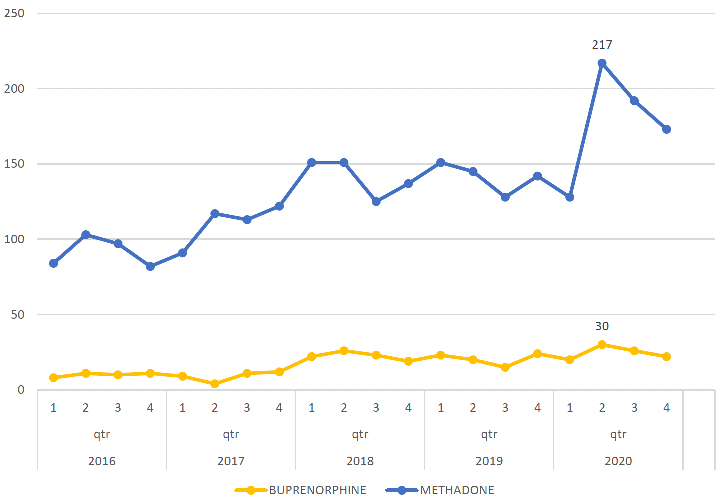
Source: NRS 2021
2.4 Source of OST implicated in death
While it is clear that there has been an increase in deaths where methadone and/or buprenorphine was implicated it is not possible to determine from NRS data alone whether the decedent was prescribed the OST or whether they obtained it illicitly.
The National Drug Related Deaths Database provides more detail around the background and circumstances of DRDs.[16] The most recent analysis uses data from 2015/2016 and shows that over one third of people who died from a DRD (37%) were prescribed an OST drug (mainly methadone) at the time of death. The percentage of people prescribed an OST at the time of death has steadily increased since 2009. Contributing factors to this rise include the ageing cohort of problem drug users and an overall increase in the number of problem drug users (particularly older drug users) in treatment.
Contact
Email: socialresearch@gov.scot
There is a problem
Thanks for your feedback